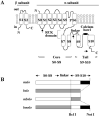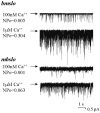Distinct regions of the slo subunit determine differential BKCa channel responses to ethanol
- PMID: 14574235
- PMCID: PMC2494946
- DOI: 10.1097/01.ALC.0000094756.41638.5D
Distinct regions of the slo subunit determine differential BKCa channel responses to ethanol
Abstract
Background: Ethanol at clinically relevant concentrations increases BKCa channel activity in dorsal root ganglia neurons, GH3 cells, and neurohypophysial terminals, leading to decreases in cell excitability and peptide release. In contrast, ethanol inhibits BKCa channels from aortic myocytes, which likely contributes to alcohol-induced aortic constriction. The mechanisms that determine differential BKCa channel responses to ethanol are unknown. We hypothesized that nonconserved regions in the BKCa channel-forming subunit (slo) are major contributors to the differential alcohol responses of different BKCa channel phenotypes.
Methods: We constructed chimeras by interchanging the core and the tail domains of two BKCa channel-forming subunits (mslo and bslo) that, after expression, differentially respond to ethanol (activation and inhibition, respectively), and studied ethanol action on these mbslo and bmslo chimeric channels using single-channel, patch-clamp techniques.
Results and conclusion: Data from cell-free membranes patches demonstrate that the activity of channels that share a mslo-type core-linker (wt mslo and the mbslo chimera) is consistently and significantly potentiated by acute exposure to ethanol. Thus, a mslo tail is not necessary for ethanol potentiation of slo channels. In contrast, the activity of channels that share a bslo-type core-linker (wt bslo and the bmslo chimera) display heterogenous responses to ethanol: inhibition (in the majority of cases), refractoriness, or activation. Overall, our data indicate that the slo core-linker is a critical region likely contributing to the differential responses of BKCa channels to ethanol.
Figures




References
-
- Butler A, Tsunoda S, McCobb DP, Wei A, Salkoff L. mSlo, a complex mouse gene encoding “maxi” calcium-activated potassium channels. Science. 1993;261:221–224. - PubMed
-
- Crowley JJ, Treistman SN, Dopico AM. Cholesterol antagonizes ethanol potentiation of human brain BKCa channels reconstituted into phospholipid bilayers. Mol Pharmacol. 2003;64:365–372. - PubMed
-
- Dopico AM, Lemos JR, Treistman SN. Ethanol increases the activity of large conductance, Ca2+-activated K+ channels in isolated neurohypophysial terminals. Mol Pharmacol. 1996;49:40–48. - PubMed
-
- Dopico AM, Anantharam V, Treistman SN. Ethanol increases the activity of Ca++-dependent K+ (mslo) channels: functional interaction with cytosolic Ca++ J Pharmacol Exp Ther. 1998;284:258–268. - PubMed
Publication types
MeSH terms
Substances
Grants and funding
LinkOut - more resources
Full Text Sources

